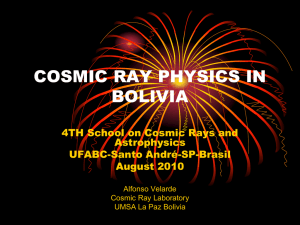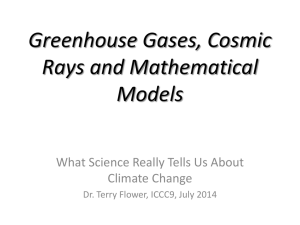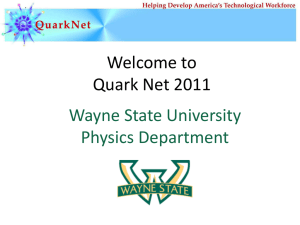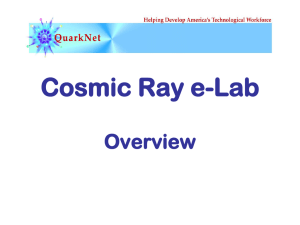PPT-presentation
advertisement
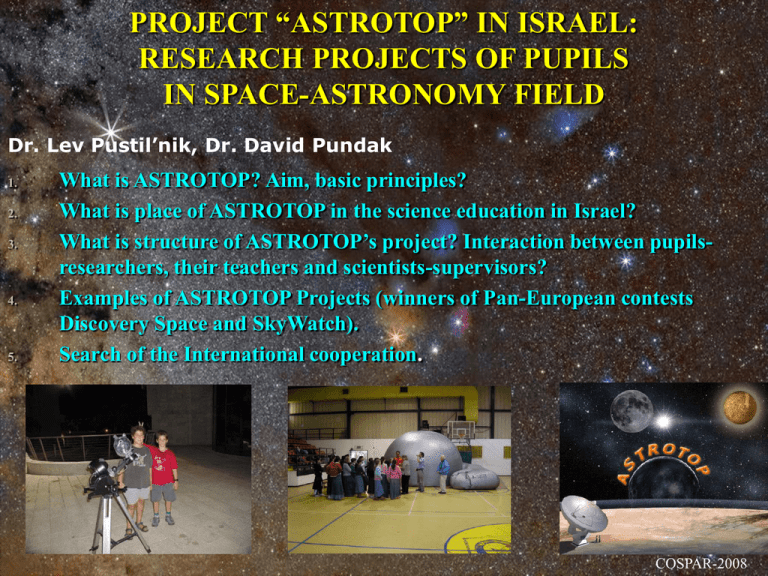
PROJECT “ASTROTOP” IN ISRAEL: RESEARCH PROJECTS OF PUPILS IN SPACE-ASTRONOMY FIELD Dr. Lev Pustil’nik, Dr. David Pundak 1. 2. 3. 4. 5. What is ASTROTOP? Aim, basic principles? What is place of ASTROTOP in the science education in Israel? What is structure of ASTROTOP’s project? Interaction between pupilsresearchers, their teachers and scientists-supervisors? Examples of ASTROTOP Projects (winners of Pan-European contests Discovery Space and SkyWatch). Search of the International cooperation. COSPAR-2008 1. What is ASTROTOP? Aim, basic principles? ASTROTOP is the system of astronomical research projects for High School students (K12) The Aim: to convert study of sciences in school and in teacher colleges from the process of violence of “stupid” pupils by “stupid” teachers into process of join research of collaborators in the field of join interest. • • • Why astronomy and space science? Change of the paradigm from study to research = change of educational unit from “knowledge” to “research project” “Privatization” of knowledge and experience by pupil Basic Principles: • • • Using of the natural interest to space-astronomy “hot” questions to “exotic” objects (from Big Bang black holes and dark energy up to space weather/solar activity influence on the Earth civilization) – themes of the project are independent choice of the pupil from wide prpared database of the themes and objects. Research and study of the several alternative hypothesis as way to find answer Preparation of the depositary of observational data and tools for its analysis in the form, accepted for pupils K12 level (electron table format and description of catalogs, images, light curves) COSPAR-2008 2.a. What is place of ASTROTOP in the system of science education? ASTROTOP is final part of the multilevel program “Blossoms of Science” • “Blossoms of Science” base on the educational approach alternative to classic: involving child in creative production of knowledge as soon as possible: form children garden and elementary school (in form of specialized computer games) up to high school students (K12) in form of mini and macro projects. Main code of the program: pupil study nature as scientist-researcher (“ask me”=Socrates' system), not as animal – object of training (army system). Main scheme is: ASTROTOP system: “question=>hypothesis=>formulation of the possible observational/experimental test=>data accumulation=>data processing=>critical analysis of results=>rejection of false hypothesis with selection of a remnant as “possibly correct” => repeating process up to rejection of the all alternative explanation beside the one, accepted as “true”” ASTROTOP allow to pupil-participants from last classes of high school to study selected actual topics of space physics/astronomy on the base of real experimental or observational data, obtained in real time or from archives of the last years, with using existed mechanisms of “Virtual Observatory” (from SOHO and GOES up to SLOAN digital survey). ASTROTOP process lead to change of pupil’s educational paradigm from “user-consumer” to “author-creator” and, in result, to “privatization” of the obtained knowledge and higher quality of knowledge. ASTROTOP give to pupils-participants basic experience of the scientific approach in search of answer on numerous questions about world around and allow to reproduce this scheme in the future in wide fields of problem. ASTROTOP for many pupils, participated in the project simulated their involving into the science and choice of the scientific career in their life as predominant version of their development in adult life. COSPAR-2008 2.b. What is place of ASTROTOP in the system of science education? ASTROTOP process lead to change of pupil’s educational paradigm from “user-consumer” to “author-creator” and, in result, to “privatization” of the obtained knowledge and higher quality of knowledge. ASTROTOP give to pupils-participants basic experience of the scientific approach in search of answer on numerous questions about world around and allow to reproduce this scheme in the future in wide fields of problem. ASTROTOP for many pupils, participated in the project simulated their involving into the science and choice of the scientific career in their life as predominant version of their development in adult life. COSPAR-2008 Technology of the ASTROTOP Selection of Subject of interest. Study of a Background. Preparation of Research Proposal. Focus on the Research Question. Formulation of Hypothesis and Criteria of their test. Planning of Methodology of Testing and Data Collection. Data Collection from Internet and our Data Base. Data Processing and Analysis of Result. Formulation of the Conclusions of the analysis and selection of the “false” and “possible true” models and theory descriptions. Final discussion with attention to new questions that arise from the Research. COSPAR-2008 Three basic elements of ASTROTOP: Close collaboration between pupilsresearchers, school teachers prepared as local supervisors, and professional scientists as scientific supervisors. Internet-Based Depositary-database of prepared scenarios of possible research (in present time – 40 scenarios, in our plan –up to 100) in the form acceptable for pupil and his teacher - supervisor Astronomical Research Projects for High School Students Support of Min. Education by additional point to authors of successful ASTROTOP research (from 1 up to 4) COSPAR-2008 50 prepared Proposals-Scenarios for ASTRO-TOP Researches The Earth and it’s surroundings Cosmic Rays • • The interaction between Cosmic Rays and the Earth Atmosphere. The interaction between Cosmic Rays, Earth Magnetosphere and Solar activity. • • • From Solar Storms in the sun to Magnetic storms on Earth. The Northern Lights: Are they dangerous? Solar eruptions and their shock waves impact on earth. From Solar Storms to Magnetic Storms The Sun Sun spots • • • • Sunspots and the Solar Magnetic Field. Proof of the solar rotation through sunspots. The Rotation of the Sun: from Galileo to present day. Solar cycle activity and the effect on the Earth. The Solar System Eclipses in the solar System • • • Lunar eclipses and measuring the radius of the moon. Solar eclipses on other planets. Eclipses of Jovian moons and measurement of the velocity of light. • • Kepler’s Laws and the definition of the masses of the planets. High and Low Tides and Cannibalism in the Universe. Kepler’s Laws in the Solar System Stars The colors of the Stars • • What does the Star’s color tell us. Populations in the world of the stars. • • • The Continual Spectrum of the Stars. The Line Spectrum of the Stars. Eclipses in the world of the Stars: Measurement of the Physical Size of the Stars through their eclipses. • • • Measuring the Mass of the Quasars in the Universe. What is the weight of the Black Hole in the Galaxy Center? Populations of the stars and nebulae in our Galaxy – Milky Way. Spectroscopy of the Stars Galaxies and Quasars The Universe The Evolution of the Universe – Hubble’s Law • • • • Run-away of galaxies from Supernova observations in them – manifestation of the dark energy. Measuring the distances and run-away velocity for spiral galaxies – Hubble law discovery. Searching for the structure of the universe on a global scale using deep survey of the galaxies in polar strip. Gamma bursts, their position on the sky and possible nature. COSPAR-2008 Example of ASTROTOP research project: The interaction between Cosmic Rays, Earth Magnetosphere and Solar activity – Project –winner in National contest 2004 (Daniel Shvartsman, Science and Art Academy, Jerusalem). The Subject The influence of the Atmosphere, Magnetosphere and Solar activity on Cosmic Ray. The Aims • • To discover the relationship between changes in atmosphere/magnetosphere and of the Cosmic Ray flux. To discover the relationship between the changes in the Cosmic Ray flux and Solar activity (shock waves in the solar wind). Objects Cosmic Ray, Atmosphere, Magnetosphere, Solar wind, Solar flare. Research questions • Background Knowledge Background in Physics: Modern Physics - movement of the charged particle in electric and magnetic fields. Astronomical Background: Cosmic Ray, Earth atmosphere and magnetosphere, Solar Wind and Solar Flares. Mathematical and Computer background: EXCEL - Statistics What is Cosmic Ray and how is it measured? What are the possible reasons for changes in Cosmic Ray with time? Dependence of Cosmic Ray to the magnetic field of magnetosphere and to the CME? Dependence between Cosmic Ray and “Space Weather”? CR Flux daily variations 8,900 8,850 Required Data Cosmic Ray Observation Data from the Global network of monitoring stations. 8,800 Stages of the project • 8,700 624 648 672 696 720 744 456 480 504 528 552 576 600 288 312 336 360 384 408 432 Cosmic Radiation: a Nasa site – introductory level. Cosmic Radiation: a Nasa site – advanced level. A Site with links to sources on Cosmic Radiation. The Cosmic Ray center in Israel (recommended). Data from Mount Hermon. Data from around the north pole: Russia / Finland. Data from Global Network on Cosmic Rays – long term. http://spidr.ngdc.noaa.gov/spidr 96 120 144 168 192 216 240 264 0 24 48 72 Collecting observational data of long time period of time (months, years) from two different 8,650 8,600 Cosmic Ray monitors: one near the north pole and the other near the equator. 8,550 Collecting data from the internet on changes of the magnetosphere with X-rays from the Sun, in the8,500 density and speed of the Solar Wind over e specific time frame. Data analysis with presentation on graphs of the synchronic changes in Cosmic Ray, magnetic field, solar wind and solar x-rays. 10000 Search correlation between changes in the magnetic Field and Cosmic Ray variations. Search of the relationship solar wind disturbances after flare and Cosmic Ray flux. 9000 Suggested sites 8,750 Flux(CR) - Moscow Sunspot Number (USA) "Anti" Spot Number 500 400 8000 300 7000 200 6000 100 5000 1958 0 1969 1980 1991 2002 COSPAR-2008 Belle Tamir, Sharet High School Nitzan Atia, Tchernichovsky High School, Netanya, Israel. Winners of the Pan-European SkyWatch Contest Athens, 2005 COSPAR-2008 COSPAR-2008 Cosmic Rays arrive to Earth by diffusion through solar wind. Modulation of solar wind by 27-d solar rotation must lead to 27-d cosmic ray variation. Cosmic ray data during solar minimum 1996-1997 from Russia and Finland show that the effect is real. 27d- variations of Cosmic rays Flux(Moscow) Model-27d 9500 Flux(Ohulu) 6650 6600 Cosmic Ray Flux 9400 6550 6500 9300 6450 9200 6400 6350 9100 6300 9000 6250 0 27 54 81 108 135 162 189 days from 01 November-1996 Time Intervals between disturbances of magnetic field (bursts Kp) in many cases are about 27 days – solar rotation period – manifestation of the 27-d “echo” effect Index Kp variation in November 1996-July 1997 Kp 6 196 5 71 4 221 120 40 14 26 18 3 168 27 2 26 45 146 182 155 26 68 28 26 25 208 27 26 1 day from 01 Nov 1996 0 1 28 55 82 109 136 163 190 217 244 271 298 COSPAR-2008 Results after 10 year experience First places in Pan-European competitions of educational project in astronomy (SkyWatch 2005 and Discovery Space 2006, SkyWatch 2007). Hundreds pupils, who tested themselves as researchers and continue this activity in universities and after. Unique experience in different national-religious-mentality groups of Israel society from orthodox Jews (Hasid's school from Migdal Ha Emeq), Arabian Muslims (school in Um Al Fahm) and Arabian Christians (school in Nazareth) up to atheist groups from kibbutzes of Jordan Valley – successful joint research in space/astrophysics field with natural experience of inter-group collaboration. COSPAR-2008 Thank you! We are interesting in collaboration with another science education groups (join projects, adaptation of ASTROTOP approach to another fields) COSPAR-2008 Blossoms of Science: Study of the world as Scientific Research. Units-Projects Kindergarten+ Elementary School: 7-13 years Units: Nano-Projects from “Touch the Sky”=1-2 h Intermediate School: 13-17 year Units: Mini-Projects in “Day of Science”, “Portable Lab and Mobile Observatory”, “Summer Astronomical Camps” =4-6 h Internet sources: “Internet Astronomical School”, “Astronomy Picture of the Day”, “Tours in the Solar System” High School: (17-18 years) - ASTROTOP Units: Macro-Projects in real astronomical themes with real observational data from solar activity up to Big Bang=100h=** back COSPAR-2008 Active Astronomy Teacher Guide • Pedagogy: – Discovery approach – Peer instruction – Student learns like a researcher – Paves the way from the class to the boundaries of the Universe. • Physics Education Research (PER) • Background in astronomy for physics teachers.






